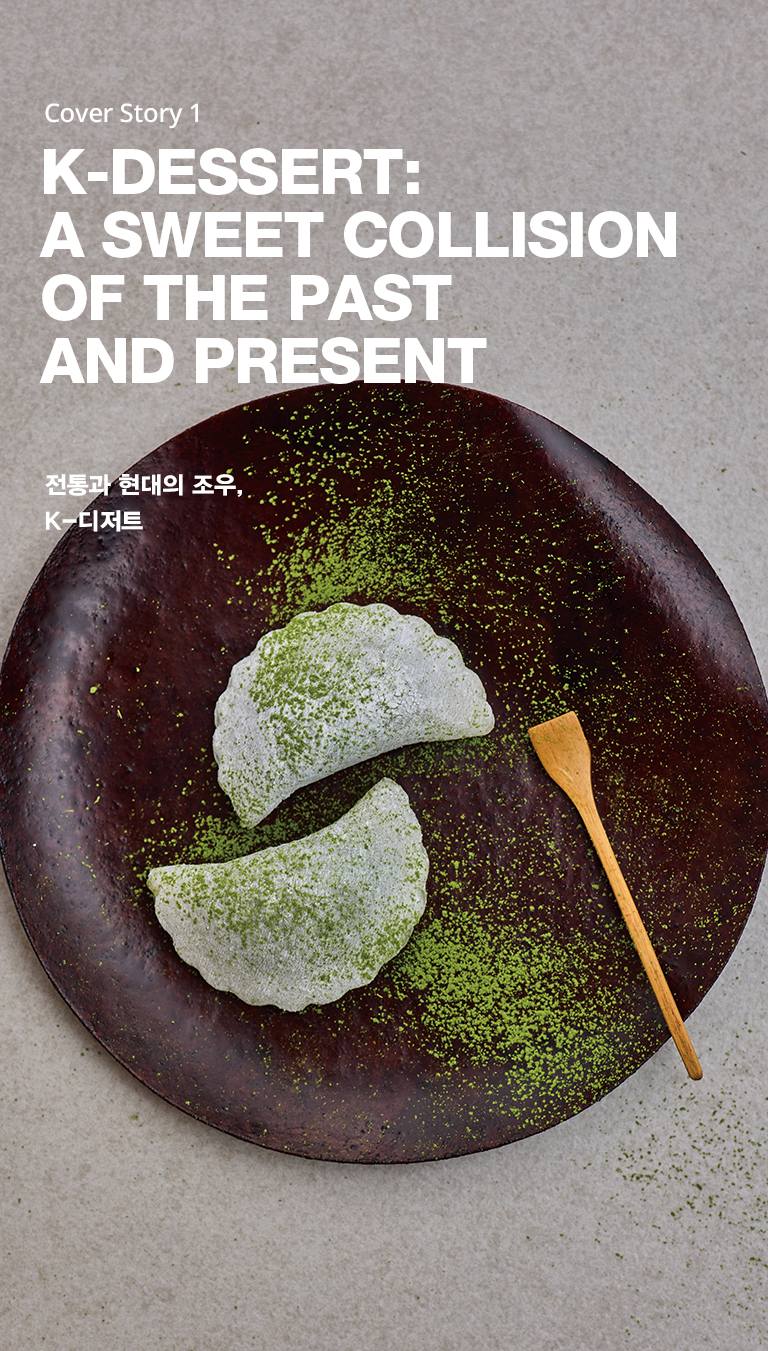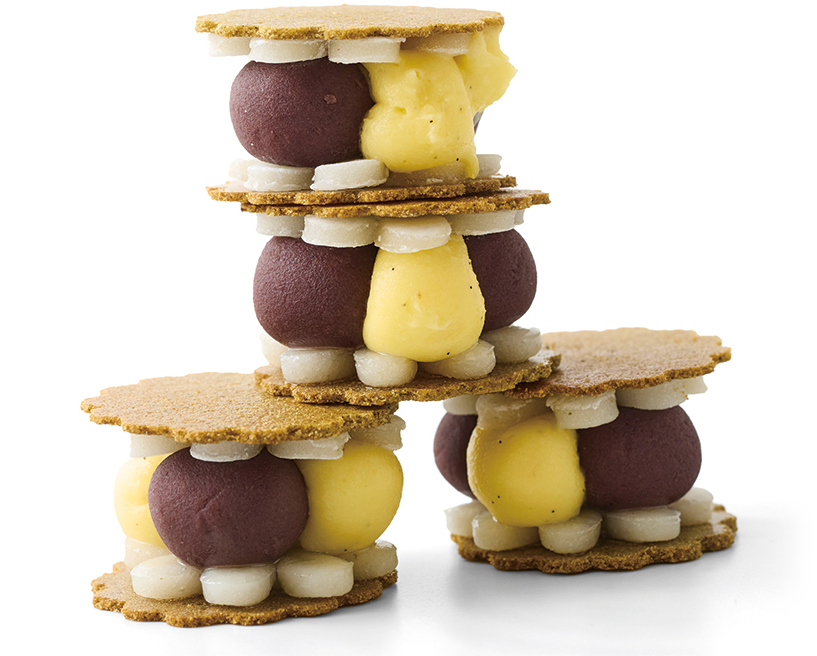
Desserts that have long been an essential part of Koreans’ everyday lives are undergoing exciting changes. The industry is getting a glow-up, with fresh ideas, fascinating recipes and innovative brands equipping Korean desserts with some sweet new flavors.
오랜 기간 한국의 일상과 맞닿아 있던 K-디저트들이 새롭게 변신 중이다. 전통에 새로운 레시피, 아이디어, 브랜딩을 입은 한국 디저트는 끊임없이 발전하며 감각적인 달콤함을 선사하고 있다.
Writer. Sung Ji Yeon
What change lies in store for Korean desserts? When ingredients and techniques from other countries are thrown into the mix, can the resulting desserts even be called Korean? Some answers to these questions can be found in the Bukchon neighborhood of Seoul at dessert brand Arari.
Arari is a brand created by the chefs behind Gaon, a pioneering member of Korea’s first generation of fine dining restaurants. The brand’s goal is to interpret traditional values through a modern aesthetic to enable “a new discovery of dessert.”
 ⓒ Arari.
ⓒ Arari.
Arari doesn’t simply preserve tradition. It grafts modern culinary techniques onto traditional materials, bringing fresh vitality. That’s exemplified by ran (meaning “egg”), one of the key components of desserts at Arari. Traditionally, a snack made from steamed chestnuts or dates, ran inspired Arari to condense raspberries and persimmons and reconstitute them as an egg-like globe wrapped in a thin membrane using techniques from molecular gastronomy.
Arari is also striving to globalize Korean sensibility. At first blush, its offerings may not appear to be traditional Korean desserts. That’s all part of Arari’s business model though—appealing to Koreans with novelty, and to tourists with familiarity. That’s why foreign visitors who encounter Arari teas filled with ran are often reminded of bubble tea. In short, the company seeks to capture the essence of tradition while lowering the entry barrier. The same goes for flavor. The yakgwa (honey cookie) are topped with chocolate instead of conventional grain syrup in a concession to both modern tastes and foreigners’ palates.
The company is sustained by its firm philosophy and skill at balancing novelty and familiarity. Flexible interpretations and solid principles are the future of Korean desserts, the foundation of a culinary culture that will appeal to diners across borders and generations.
 ⓒ Arari.
ⓒ Arari.
Yakgwa is a traditional Korean confection made by kneading sesame oil, honey and alcohol into fine glutinous rice flour and then frying the dough. The treat was once a prized delicacy often served at important events and presented to honored guests. But as Western desserts spread through Korea after its liberation from Japanese colonial rule (1945), yakgwa’s popularity began to fade.
As of 2025, yakgwa has regained its ancient status as a top-shelf dessert, largely thanks to the efforts of Yang Ji-woo, CEO of Golden Piece, who had “dreamed of creating a must-try dessert for foreign visitors.” For Yang, yakgwa was a dessert with infinite growth potential. “For a long time, yakgwa was always distributed in plastic wrap with the same floral design and the same flavor. But yakgwa struck me as a blank canvas. I thought if we incorporated people’s favorite flavors, beautified the design, and presented it in deluxe packaging, it could become a completely new dessert,” Yang said.
 ⓒ Golden Piece.
ⓒ Golden Piece.
Yang began tinkering with the various elements of yakgwa to create a product that would be unique to Golden Piece. The result was extraordinary. People who saw the company’s pastries could hardly believe they were yakgwa. The product is distinguished by its texture and flavor. Vanilla is added to the grain syrup, dough and toppings in a combination of Asian and Western flavors, while the cookies are topped with Earl Grey-flavored cream or lemon yogurt, creating a layered texture that sets off yakgwa’s original flavor. So far, the company has developed 14 distinct flavors that showcase the potential of Korea’s traditional confection.
Golden Piece’s exquisite fusion of Asian and Western elements is also apparent in its product design. From a distance, the illustrations on the tin case look like what one might see in a Western children’s story. But a closer look reveals an exquisite Korean folk painting of rabbits carrying yakgwa. As this suggests, Golden Piece’s clever branding bridges the gap between East and West, serving as inspiration for ongoing attempts to upgrade the Korean dessert market.
Golden Piece’s yakgwa have secured an enduring popularity not only in Korea but also overseas. The brand is represented at high-end department stores as well as airport duty-free stores, where it has become one of the most-sought-after products for foreign tourists. Golden Piece’s success has inspired Korean confectioners to target the high-end market with contemporary variations and interpretations of traditional treats, piquing curiosity about the company’s next move.
One Korean treat captured the taste buds of visitors to the Asia-Pacific Economic Cooperation (APEC) Meetings: hodugwaja, or walnut cakes. These bake-to-order confections are made by stuffing wheat dough with walnuts and red bean paste. It’s a familiar flavor for pretty much any Korean. But the hodugwaja served up for APEC dignitaries were a novel interpretation of the dish created by Lee Gyeong-won, CEO of Korean food company FG.
Buchang Bakery began as a neighborhood bakery in Gyeongju in the 1960s but eventually shut down in the 1990s. Then last October, the bakery was reopened by Lee, the founder’s grandson. Soon after launch, the rebooted bakery became a sensation, with eager customers lining up at department stores every morning. Within six months, the store had sold 100 million of its signature hodugwaja sets, bringing in KRW 1.5 billion in monthly sales. Foreign media clamored to cover the bakery, which is also preparing to collaborate with Japanese department stores. Given its success, the bakery was selected as an official supplier for APEC, bringing the hodugwaja that are one of Korea’s time-tested desserts to global attention.
 ⓒ Buchang Bakery.
ⓒ Buchang Bakery.
Simply resurrecting the old-timey name doesn’t fully explain the enthusiastic response to the new hodugwaja shop. More significant is the business philosophy Lee adopted for Buchang Bakery: “adding minor variations to Korean fundamentals.” That one sentence sums up the bakery’s raison d’être.
The bakery’s top priority is preserving the fundamentals. Lee believes that Korean confectionery needs to focus on the foods Koreans have enjoyed for generations. As such, the bakery preserves hodugwaja’s round shape, as well as the practice of baking it on the spot. Baking to order gives the bakery an edge over its competition, even in a bustling department store. As for brand design, Buchang Bakery opted for retro concepts with a traditional vibe.
The next essential element is variation. Believing that tradition alone would not bring in customers, Lee Gyeong-won focused on offering a diverse range of flavors. He collaborated with actor Lee Jang-woo to develop recipes for new fillings—not only red beans, in other words, but also black sesame, injeolmi (bean-powder-coated rice cake) and green pea mash. Fillings based on sweet potatoes, corn and matcha were also added to represent regional Korean delicacies. The bakery even developed a custard containing salt from the Salar de Uyuni in Bolivia, the world’s largest salt flat, highlighting the growth potential for Korean desserts. This vindicated the restaurateur’s intuition that “building exotic ingredients and ideas atop a Korean foundation is bound to win over more customers.”
In short, one of Lee’s new hodugwaja embraces Korean traditions while also accommodating global taste buds. The brand’s contemporary sensibility and solid storytelling are driven home by the undeniably scrumptious flavor when those cookies enter your mouth. Lee’s next goal, he says, is positioning his hodugwaja at the center of Korean dessert culture. “Just a decade ago, the globalization of Korean culture felt like a distant dream, but now it’s become a reality. As part of that trend, I hope our hodugwaja will establish themselves as a leading confection that convey Korean culture and sensibility,” he said.
 Photos Courtesy of Buchang Bakery
Photos Courtesy of Buchang Bakery